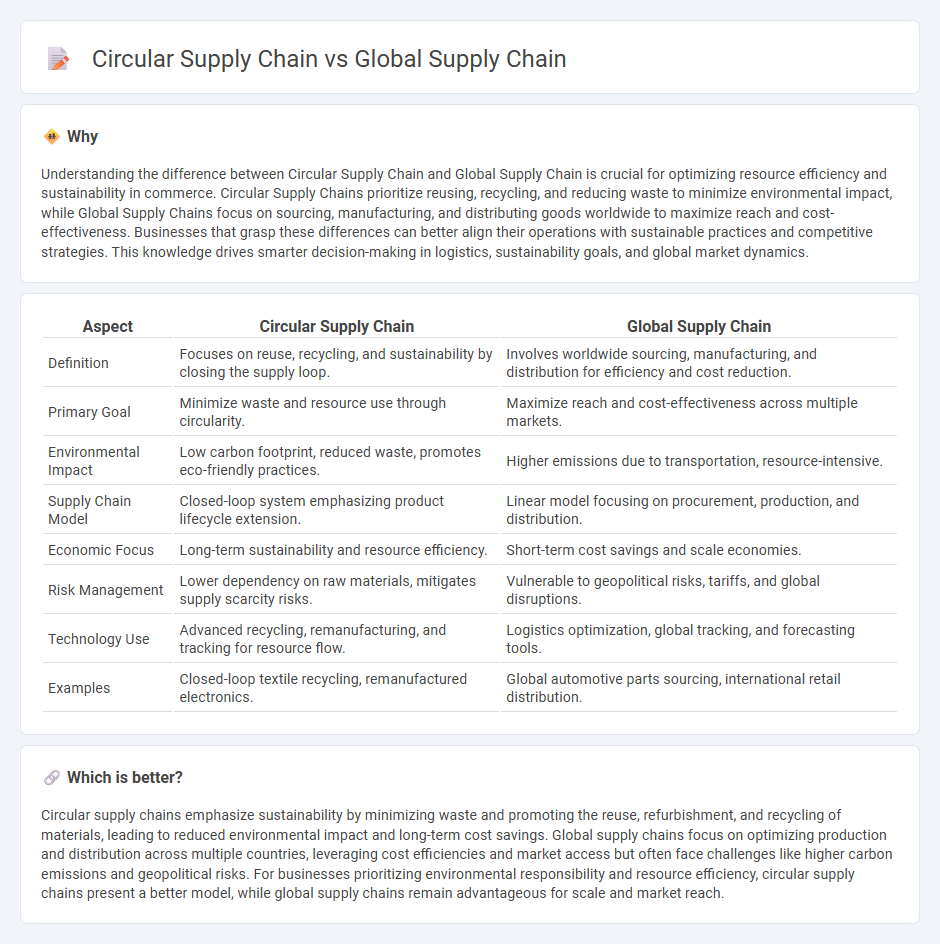
A circular supply chain focuses on sustainability by minimizing waste and recycling resources, promoting eco-friendly production and consumption cycles. In contrast, a global supply chain emphasizes efficiency and scale by sourcing materials and products across international borders to meet worldwide demand. Explore more to understand how these supply chain models impact business strategy and environmental responsibility.
Why it is important
Understanding the difference between Circular Supply Chain and Global Supply Chain is crucial for optimizing resource efficiency and sustainability in commerce. Circular Supply Chains prioritize reusing, recycling, and reducing waste to minimize environmental impact, while Global Supply Chains focus on sourcing, manufacturing, and distributing goods worldwide to maximize reach and cost-effectiveness. Businesses that grasp these differences can better align their operations with sustainable practices and competitive strategies. This knowledge drives smarter decision-making in logistics, sustainability goals, and global market dynamics.
Comparison Table
| Aspect | Circular Supply Chain | Global Supply Chain |
|---|---|---|
| Definition | Focuses on reuse, recycling, and sustainability by closing the supply loop. | Involves worldwide sourcing, manufacturing, and distribution for efficiency and cost reduction. |
| Primary Goal | Minimize waste and resource use through circularity. | Maximize reach and cost-effectiveness across multiple markets. |
| Environmental Impact | Low carbon footprint, reduced waste, promotes eco-friendly practices. | Higher emissions due to transportation, resource-intensive. |
| Supply Chain Model | Closed-loop system emphasizing product lifecycle extension. | Linear model focusing on procurement, production, and distribution. |
| Economic Focus | Long-term sustainability and resource efficiency. | Short-term cost savings and scale economies. |
| Risk Management | Lower dependency on raw materials, mitigates supply scarcity risks. | Vulnerable to geopolitical risks, tariffs, and global disruptions. |
| Technology Use | Advanced recycling, remanufacturing, and tracking for resource flow. | Logistics optimization, global tracking, and forecasting tools. |
| Examples | Closed-loop textile recycling, remanufactured electronics. | Global automotive parts sourcing, international retail distribution. |
Which is better?
Circular supply chains emphasize sustainability by minimizing waste and promoting the reuse, refurbishment, and recycling of materials, leading to reduced environmental impact and long-term cost savings. Global supply chains focus on optimizing production and distribution across multiple countries, leveraging cost efficiencies and market access but often face challenges like higher carbon emissions and geopolitical risks. For businesses prioritizing environmental responsibility and resource efficiency, circular supply chains present a better model, while global supply chains remain advantageous for scale and market reach.
Connection
Circular supply chains integrate global supply chain operations by promoting the reuse, recycling, and remanufacturing of products and materials across international borders. This connection enhances resource efficiency and reduces waste within global commerce networks, aligning sustainability goals with economic growth. Data reveals companies adopting circular supply chains report up to 30% reduction in raw material costs while maintaining global market reach.
Key Terms
Sourcing
Global supply chains emphasize sourcing raw materials from diverse international suppliers to optimize cost and availability, often leading to complex logistics and higher carbon footprints. Circular supply chains prioritize sustainable sourcing by integrating recycled, renewable, or locally sourced materials to minimize waste and environmental impact. Explore the benefits and strategies behind sourcing in circular supply chain models to enhance sustainability and efficiency.
Resource Looping
Global supply chains often operate on a linear model emphasizing extraction, production, distribution, and disposal, leading to significant resource depletion and waste. Circular supply chains prioritize resource looping by designing products and processes that enable reuse, remanufacturing, and recycling, thereby minimizing environmental impact and enhancing sustainability. Explore more to understand how circular supply chains are transforming resource management and reducing global waste.
Waste Minimization
Global supply chains often prioritize efficiency and cost reduction, leading to significant waste generation through overproduction, transportation emissions, and packaging. Circular supply chains emphasize waste minimization by designing products for reuse, remanufacturing, and recycling, thus closing the loop and reducing environmental impact. Explore how businesses transition from linear to circular models to enhance sustainability and minimize waste.
Source and External Links
Global Supply Chains in 2025: Issues, Trends, and Solutions - Complex networks spanning multiple countries that allow businesses to source, manufacture, and distribute goods internationally, emphasizing logistics planning, cost minimization, and risk diversification.
Global Supply Chain Management - CIPS - Global supply chains involve the flow of information, goods, and services across continents, managed through strategic sourcing, logistics, and compliance with international regulations to enhance efficiency and reduce risks.
What is a Global Supply Chain | BDC.ca - A supply chain where each step--from sourcing materials to manufacturing and delivery--occurs in different countries, reflecting the interconnected nature of modern global trade.
 dowidth.com
dowidth.com